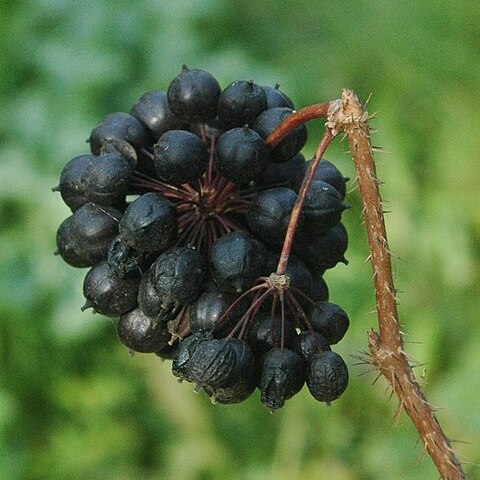Shrubs, to 6 m tall. Branches with dense to scattered, slender, terete, bristlelike prickles. Petiole 3-12 cm, slender, sometimes with fine prickles; petiolule of central leaflet (0.6-)1.2-2 cm, usually brownish pubescent; leaflets (3-)5, elliptic-obovate or oblong, 5-13 × 3-7 cm, papery, abaxially pubescent on veins, adaxially with scattered hairs, secondary veins 6 or 7 pairs, conspicuous on both surfaces, base broadly cuneate, margin sharply biserrate, apex shortly acuminate or acuminate. Inflorescence terminal, a solitary or compound umbel, borne on leafy shoots, usually with 2-6 umbels together; peduncles 5-7 cm, glabrous; pedicels 1-2 cm, glabrous or slightly pubescent at base. Calyx subentire or with 5 inconspicuous teeth, glabrous. Corolla purple-yellow. Ovary 5-carpellate; styles united into a column. Fruit ovoid-globose, ca. 8 mm; styles persistent, ca. 1.5 mm. Fl. Jun-Jul, fr. Aug-Oct.
More
A deciduous shrub. It forms suckers. It has thick roots. It grows 6 m high. It has only a few branches. It has bristles and prickles. The leaves are dark green and divided like fingers on a hand. They are 15 cm across. The female flowers are green and the male flowers are purple. They are small and star shaped and occur in groups. The fruit are black. The fruit are 8 mm across.
Mixed and coniferous mountain forests, forming small undergrowth or groups in thickets and edges. Sometimes found in oak groves at the foot of cliffs, very rarely in high forest riparian woodland.
More
It is a temperate plant. It needs well drained soil. It can grow in sun or part shade. It grows in Inner Mongolia in China. It suits hardiness zones 3-8. In Sichuan.

